Analyzing Team Performance Management: HR Challenges & Solutions
VerifiedAdded on 2023/04/06
|9
|1897
|200
Report
AI Summary
This report critically evaluates the role of the HR department in developing policies that cater to employee needs and achieve organizational goals. It discusses factors affecting employee performance, including motivation and effective communication, highlighting Maslow's hierarchy of needs ...
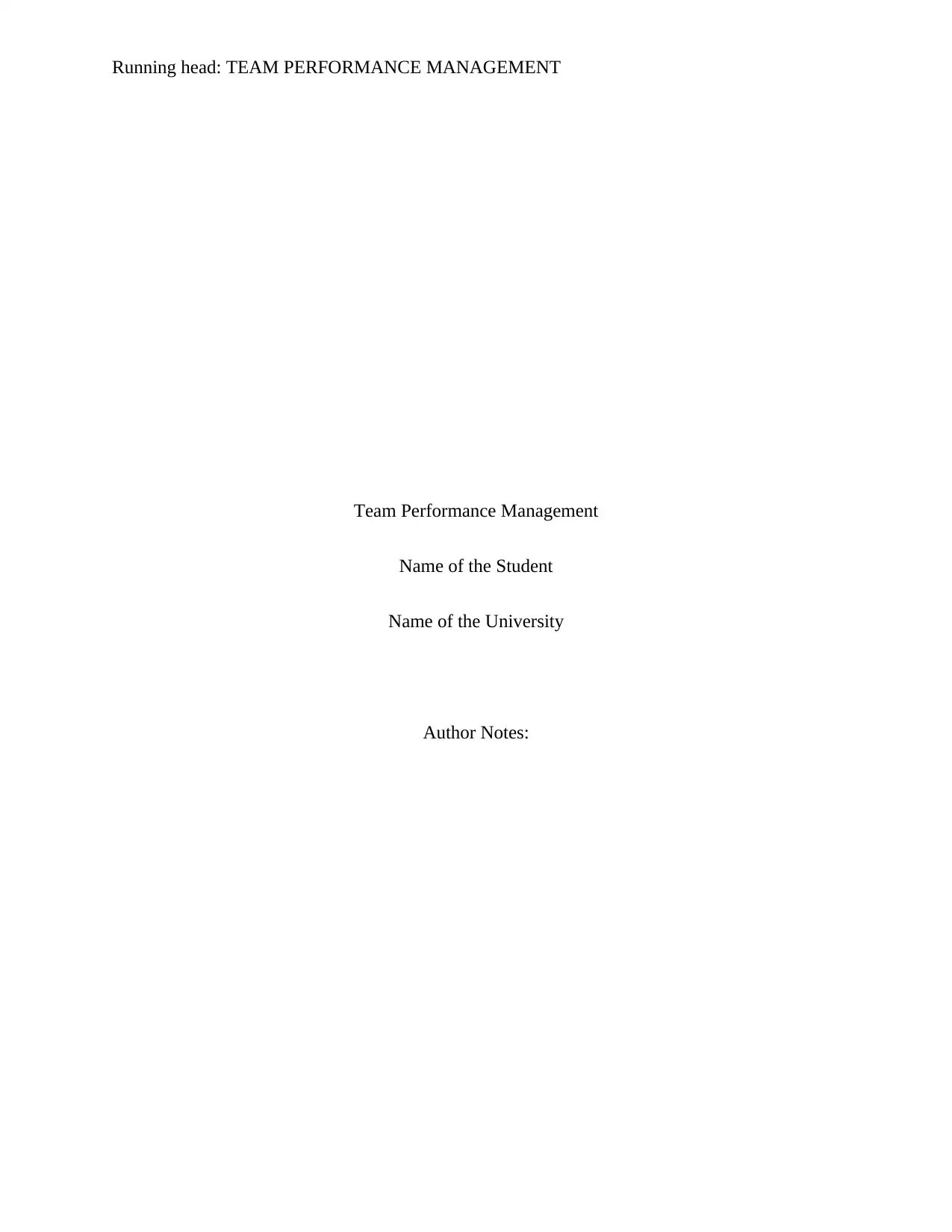
Running head: TEAM PERFORMANCE MANAGEMENT
Team Performance Management
Name of the Student
Name of the University
Author Notes:
Team Performance Management
Name of the Student
Name of the University
Author Notes:
Paraphrase This Document
Need a fresh take? Get an instant paraphrase of this document with our AI Paraphraser
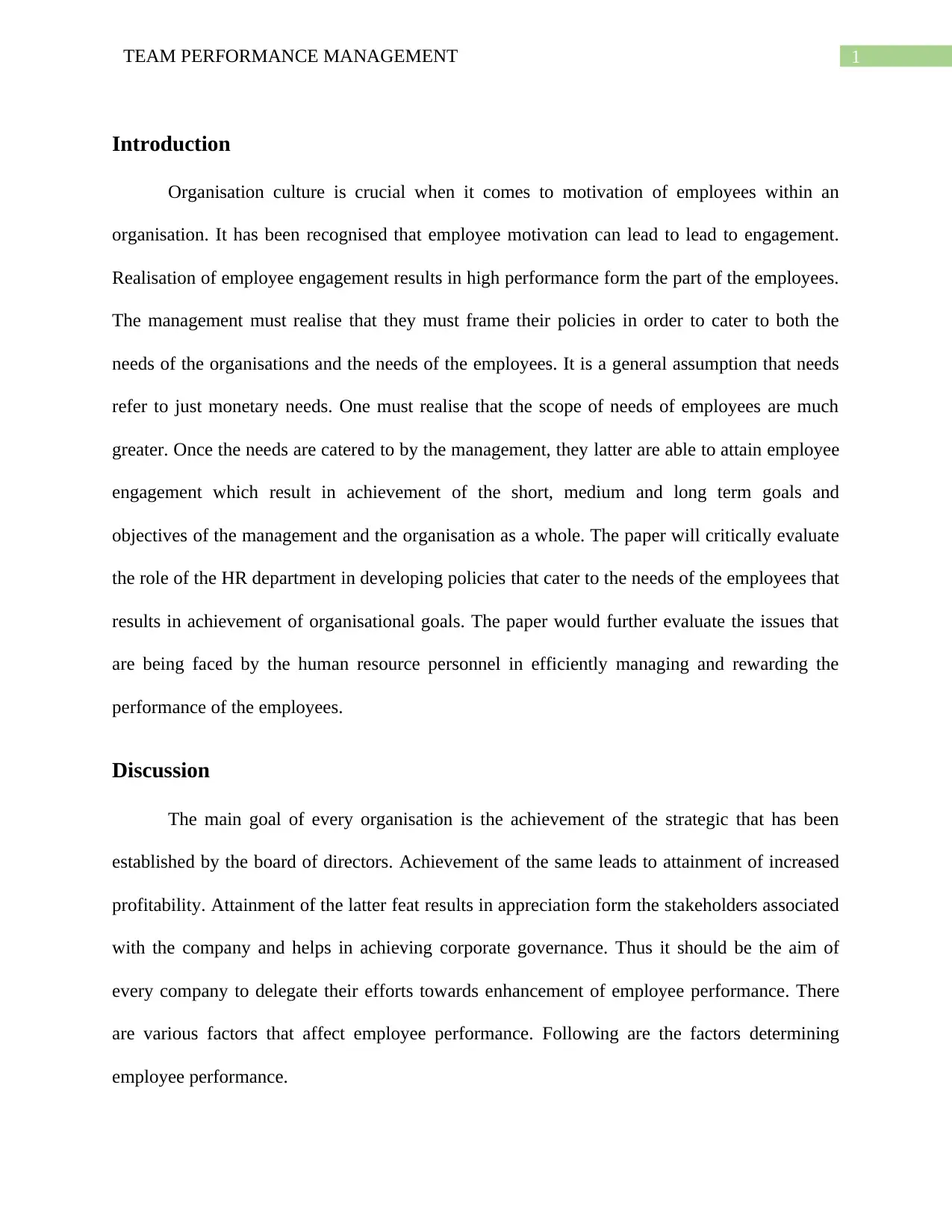
1TEAM PERFORMANCE MANAGEMENT
Introduction
Organisation culture is crucial when it comes to motivation of employees within an
organisation. It has been recognised that employee motivation can lead to lead to engagement.
Realisation of employee engagement results in high performance form the part of the employees.
The management must realise that they must frame their policies in order to cater to both the
needs of the organisations and the needs of the employees. It is a general assumption that needs
refer to just monetary needs. One must realise that the scope of needs of employees are much
greater. Once the needs are catered to by the management, they latter are able to attain employee
engagement which result in achievement of the short, medium and long term goals and
objectives of the management and the organisation as a whole. The paper will critically evaluate
the role of the HR department in developing policies that cater to the needs of the employees that
results in achievement of organisational goals. The paper would further evaluate the issues that
are being faced by the human resource personnel in efficiently managing and rewarding the
performance of the employees.
Discussion
The main goal of every organisation is the achievement of the strategic that has been
established by the board of directors. Achievement of the same leads to attainment of increased
profitability. Attainment of the latter feat results in appreciation form the stakeholders associated
with the company and helps in achieving corporate governance. Thus it should be the aim of
every company to delegate their efforts towards enhancement of employee performance. There
are various factors that affect employee performance. Following are the factors determining
employee performance.
Introduction
Organisation culture is crucial when it comes to motivation of employees within an
organisation. It has been recognised that employee motivation can lead to lead to engagement.
Realisation of employee engagement results in high performance form the part of the employees.
The management must realise that they must frame their policies in order to cater to both the
needs of the organisations and the needs of the employees. It is a general assumption that needs
refer to just monetary needs. One must realise that the scope of needs of employees are much
greater. Once the needs are catered to by the management, they latter are able to attain employee
engagement which result in achievement of the short, medium and long term goals and
objectives of the management and the organisation as a whole. The paper will critically evaluate
the role of the HR department in developing policies that cater to the needs of the employees that
results in achievement of organisational goals. The paper would further evaluate the issues that
are being faced by the human resource personnel in efficiently managing and rewarding the
performance of the employees.
Discussion
The main goal of every organisation is the achievement of the strategic that has been
established by the board of directors. Achievement of the same leads to attainment of increased
profitability. Attainment of the latter feat results in appreciation form the stakeholders associated
with the company and helps in achieving corporate governance. Thus it should be the aim of
every company to delegate their efforts towards enhancement of employee performance. There
are various factors that affect employee performance. Following are the factors determining
employee performance.
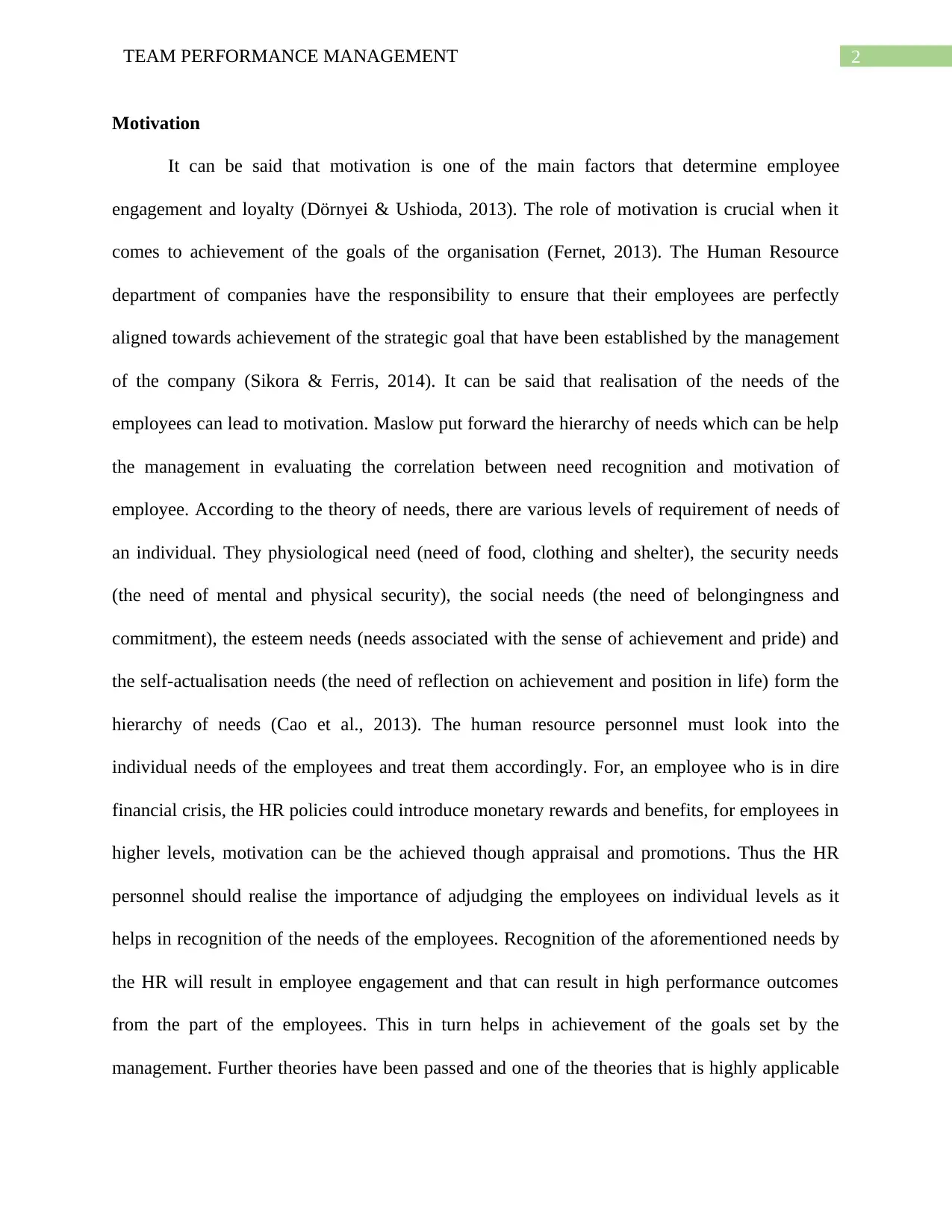
2TEAM PERFORMANCE MANAGEMENT
Motivation
It can be said that motivation is one of the main factors that determine employee
engagement and loyalty (Dörnyei & Ushioda, 2013). The role of motivation is crucial when it
comes to achievement of the goals of the organisation (Fernet, 2013). The Human Resource
department of companies have the responsibility to ensure that their employees are perfectly
aligned towards achievement of the strategic goal that have been established by the management
of the company (Sikora & Ferris, 2014). It can be said that realisation of the needs of the
employees can lead to motivation. Maslow put forward the hierarchy of needs which can be help
the management in evaluating the correlation between need recognition and motivation of
employee. According to the theory of needs, there are various levels of requirement of needs of
an individual. They physiological need (need of food, clothing and shelter), the security needs
(the need of mental and physical security), the social needs (the need of belongingness and
commitment), the esteem needs (needs associated with the sense of achievement and pride) and
the self-actualisation needs (the need of reflection on achievement and position in life) form the
hierarchy of needs (Cao et al., 2013). The human resource personnel must look into the
individual needs of the employees and treat them accordingly. For, an employee who is in dire
financial crisis, the HR policies could introduce monetary rewards and benefits, for employees in
higher levels, motivation can be the achieved though appraisal and promotions. Thus the HR
personnel should realise the importance of adjudging the employees on individual levels as it
helps in recognition of the needs of the employees. Recognition of the aforementioned needs by
the HR will result in employee engagement and that can result in high performance outcomes
from the part of the employees. This in turn helps in achievement of the goals set by the
management. Further theories have been passed and one of the theories that is highly applicable
Motivation
It can be said that motivation is one of the main factors that determine employee
engagement and loyalty (Dörnyei & Ushioda, 2013). The role of motivation is crucial when it
comes to achievement of the goals of the organisation (Fernet, 2013). The Human Resource
department of companies have the responsibility to ensure that their employees are perfectly
aligned towards achievement of the strategic goal that have been established by the management
of the company (Sikora & Ferris, 2014). It can be said that realisation of the needs of the
employees can lead to motivation. Maslow put forward the hierarchy of needs which can be help
the management in evaluating the correlation between need recognition and motivation of
employee. According to the theory of needs, there are various levels of requirement of needs of
an individual. They physiological need (need of food, clothing and shelter), the security needs
(the need of mental and physical security), the social needs (the need of belongingness and
commitment), the esteem needs (needs associated with the sense of achievement and pride) and
the self-actualisation needs (the need of reflection on achievement and position in life) form the
hierarchy of needs (Cao et al., 2013). The human resource personnel must look into the
individual needs of the employees and treat them accordingly. For, an employee who is in dire
financial crisis, the HR policies could introduce monetary rewards and benefits, for employees in
higher levels, motivation can be the achieved though appraisal and promotions. Thus the HR
personnel should realise the importance of adjudging the employees on individual levels as it
helps in recognition of the needs of the employees. Recognition of the aforementioned needs by
the HR will result in employee engagement and that can result in high performance outcomes
from the part of the employees. This in turn helps in achievement of the goals set by the
management. Further theories have been passed and one of the theories that is highly applicable
You're viewing a preview
Unlock full access by subscribing today!
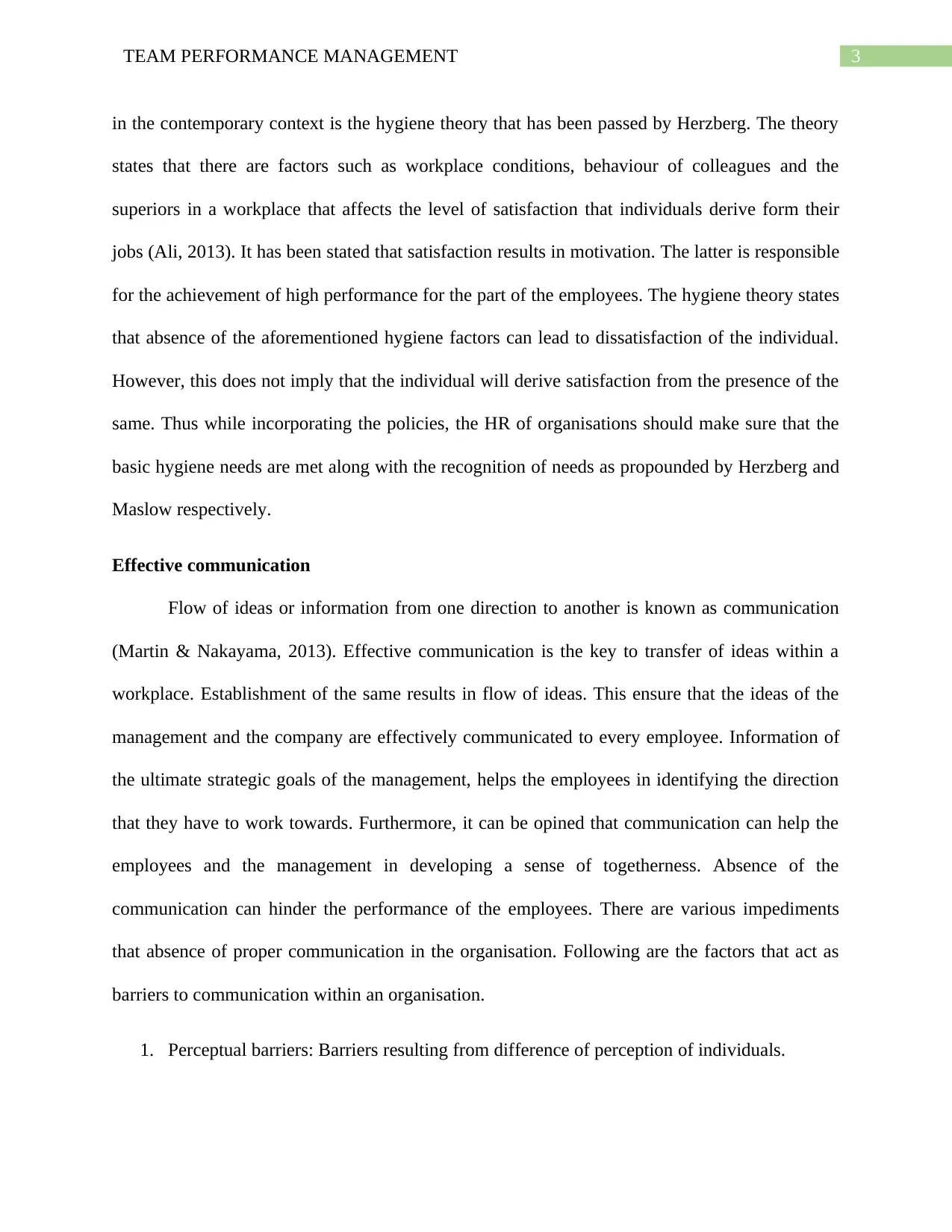
3TEAM PERFORMANCE MANAGEMENT
in the contemporary context is the hygiene theory that has been passed by Herzberg. The theory
states that there are factors such as workplace conditions, behaviour of colleagues and the
superiors in a workplace that affects the level of satisfaction that individuals derive form their
jobs (Ali, 2013). It has been stated that satisfaction results in motivation. The latter is responsible
for the achievement of high performance for the part of the employees. The hygiene theory states
that absence of the aforementioned hygiene factors can lead to dissatisfaction of the individual.
However, this does not imply that the individual will derive satisfaction from the presence of the
same. Thus while incorporating the policies, the HR of organisations should make sure that the
basic hygiene needs are met along with the recognition of needs as propounded by Herzberg and
Maslow respectively.
Effective communication
Flow of ideas or information from one direction to another is known as communication
(Martin & Nakayama, 2013). Effective communication is the key to transfer of ideas within a
workplace. Establishment of the same results in flow of ideas. This ensure that the ideas of the
management and the company are effectively communicated to every employee. Information of
the ultimate strategic goals of the management, helps the employees in identifying the direction
that they have to work towards. Furthermore, it can be opined that communication can help the
employees and the management in developing a sense of togetherness. Absence of the
communication can hinder the performance of the employees. There are various impediments
that absence of proper communication in the organisation. Following are the factors that act as
barriers to communication within an organisation.
1. Perceptual barriers: Barriers resulting from difference of perception of individuals.
in the contemporary context is the hygiene theory that has been passed by Herzberg. The theory
states that there are factors such as workplace conditions, behaviour of colleagues and the
superiors in a workplace that affects the level of satisfaction that individuals derive form their
jobs (Ali, 2013). It has been stated that satisfaction results in motivation. The latter is responsible
for the achievement of high performance for the part of the employees. The hygiene theory states
that absence of the aforementioned hygiene factors can lead to dissatisfaction of the individual.
However, this does not imply that the individual will derive satisfaction from the presence of the
same. Thus while incorporating the policies, the HR of organisations should make sure that the
basic hygiene needs are met along with the recognition of needs as propounded by Herzberg and
Maslow respectively.
Effective communication
Flow of ideas or information from one direction to another is known as communication
(Martin & Nakayama, 2013). Effective communication is the key to transfer of ideas within a
workplace. Establishment of the same results in flow of ideas. This ensure that the ideas of the
management and the company are effectively communicated to every employee. Information of
the ultimate strategic goals of the management, helps the employees in identifying the direction
that they have to work towards. Furthermore, it can be opined that communication can help the
employees and the management in developing a sense of togetherness. Absence of the
communication can hinder the performance of the employees. There are various impediments
that absence of proper communication in the organisation. Following are the factors that act as
barriers to communication within an organisation.
1. Perceptual barriers: Barriers resulting from difference of perception of individuals.
Paraphrase This Document
Need a fresh take? Get an instant paraphrase of this document with our AI Paraphraser
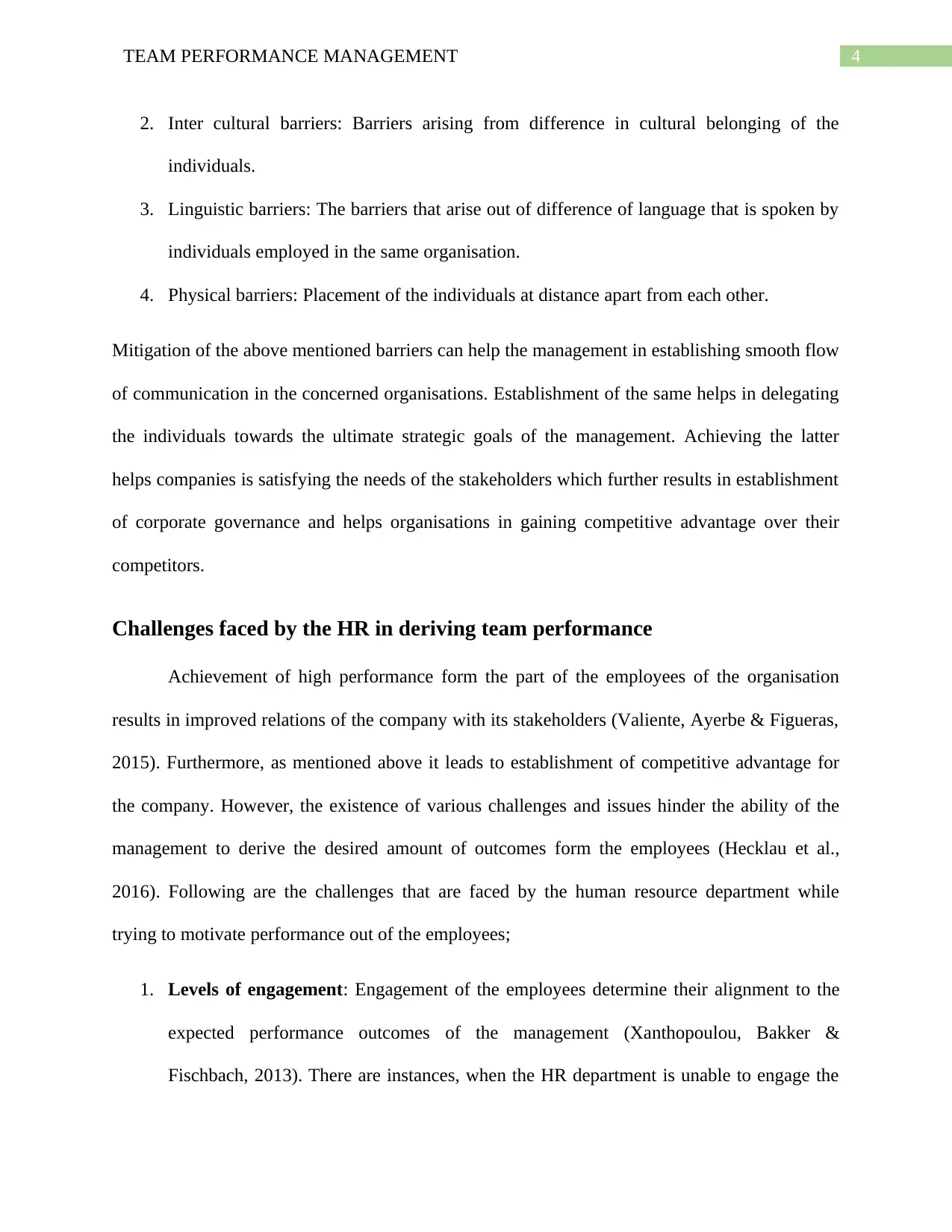
4TEAM PERFORMANCE MANAGEMENT
2. Inter cultural barriers: Barriers arising from difference in cultural belonging of the
individuals.
3. Linguistic barriers: The barriers that arise out of difference of language that is spoken by
individuals employed in the same organisation.
4. Physical barriers: Placement of the individuals at distance apart from each other.
Mitigation of the above mentioned barriers can help the management in establishing smooth flow
of communication in the concerned organisations. Establishment of the same helps in delegating
the individuals towards the ultimate strategic goals of the management. Achieving the latter
helps companies is satisfying the needs of the stakeholders which further results in establishment
of corporate governance and helps organisations in gaining competitive advantage over their
competitors.
Challenges faced by the HR in deriving team performance
Achievement of high performance form the part of the employees of the organisation
results in improved relations of the company with its stakeholders (Valiente, Ayerbe & Figueras,
2015). Furthermore, as mentioned above it leads to establishment of competitive advantage for
the company. However, the existence of various challenges and issues hinder the ability of the
management to derive the desired amount of outcomes form the employees (Hecklau et al.,
2016). Following are the challenges that are faced by the human resource department while
trying to motivate performance out of the employees;
1. Levels of engagement: Engagement of the employees determine their alignment to the
expected performance outcomes of the management (Xanthopoulou, Bakker &
Fischbach, 2013). There are instances, when the HR department is unable to engage the
2. Inter cultural barriers: Barriers arising from difference in cultural belonging of the
individuals.
3. Linguistic barriers: The barriers that arise out of difference of language that is spoken by
individuals employed in the same organisation.
4. Physical barriers: Placement of the individuals at distance apart from each other.
Mitigation of the above mentioned barriers can help the management in establishing smooth flow
of communication in the concerned organisations. Establishment of the same helps in delegating
the individuals towards the ultimate strategic goals of the management. Achieving the latter
helps companies is satisfying the needs of the stakeholders which further results in establishment
of corporate governance and helps organisations in gaining competitive advantage over their
competitors.
Challenges faced by the HR in deriving team performance
Achievement of high performance form the part of the employees of the organisation
results in improved relations of the company with its stakeholders (Valiente, Ayerbe & Figueras,
2015). Furthermore, as mentioned above it leads to establishment of competitive advantage for
the company. However, the existence of various challenges and issues hinder the ability of the
management to derive the desired amount of outcomes form the employees (Hecklau et al.,
2016). Following are the challenges that are faced by the human resource department while
trying to motivate performance out of the employees;
1. Levels of engagement: Engagement of the employees determine their alignment to the
expected performance outcomes of the management (Xanthopoulou, Bakker &
Fischbach, 2013). There are instances, when the HR department is unable to engage the
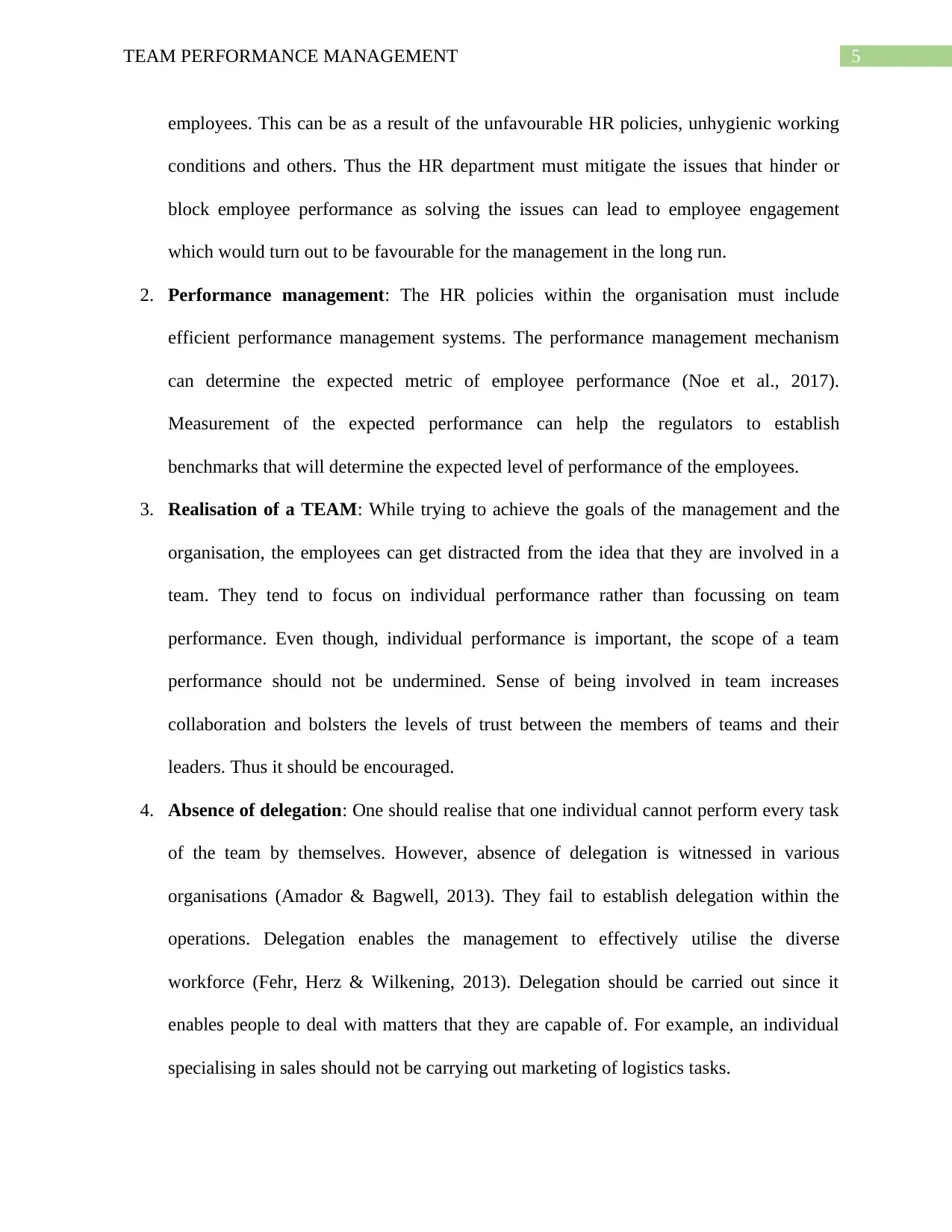
5TEAM PERFORMANCE MANAGEMENT
employees. This can be as a result of the unfavourable HR policies, unhygienic working
conditions and others. Thus the HR department must mitigate the issues that hinder or
block employee performance as solving the issues can lead to employee engagement
which would turn out to be favourable for the management in the long run.
2. Performance management: The HR policies within the organisation must include
efficient performance management systems. The performance management mechanism
can determine the expected metric of employee performance (Noe et al., 2017).
Measurement of the expected performance can help the regulators to establish
benchmarks that will determine the expected level of performance of the employees.
3. Realisation of a TEAM: While trying to achieve the goals of the management and the
organisation, the employees can get distracted from the idea that they are involved in a
team. They tend to focus on individual performance rather than focussing on team
performance. Even though, individual performance is important, the scope of a team
performance should not be undermined. Sense of being involved in team increases
collaboration and bolsters the levels of trust between the members of teams and their
leaders. Thus it should be encouraged.
4. Absence of delegation: One should realise that one individual cannot perform every task
of the team by themselves. However, absence of delegation is witnessed in various
organisations (Amador & Bagwell, 2013). They fail to establish delegation within the
operations. Delegation enables the management to effectively utilise the diverse
workforce (Fehr, Herz & Wilkening, 2013). Delegation should be carried out since it
enables people to deal with matters that they are capable of. For example, an individual
specialising in sales should not be carrying out marketing of logistics tasks.
employees. This can be as a result of the unfavourable HR policies, unhygienic working
conditions and others. Thus the HR department must mitigate the issues that hinder or
block employee performance as solving the issues can lead to employee engagement
which would turn out to be favourable for the management in the long run.
2. Performance management: The HR policies within the organisation must include
efficient performance management systems. The performance management mechanism
can determine the expected metric of employee performance (Noe et al., 2017).
Measurement of the expected performance can help the regulators to establish
benchmarks that will determine the expected level of performance of the employees.
3. Realisation of a TEAM: While trying to achieve the goals of the management and the
organisation, the employees can get distracted from the idea that they are involved in a
team. They tend to focus on individual performance rather than focussing on team
performance. Even though, individual performance is important, the scope of a team
performance should not be undermined. Sense of being involved in team increases
collaboration and bolsters the levels of trust between the members of teams and their
leaders. Thus it should be encouraged.
4. Absence of delegation: One should realise that one individual cannot perform every task
of the team by themselves. However, absence of delegation is witnessed in various
organisations (Amador & Bagwell, 2013). They fail to establish delegation within the
operations. Delegation enables the management to effectively utilise the diverse
workforce (Fehr, Herz & Wilkening, 2013). Delegation should be carried out since it
enables people to deal with matters that they are capable of. For example, an individual
specialising in sales should not be carrying out marketing of logistics tasks.
You're viewing a preview
Unlock full access by subscribing today!
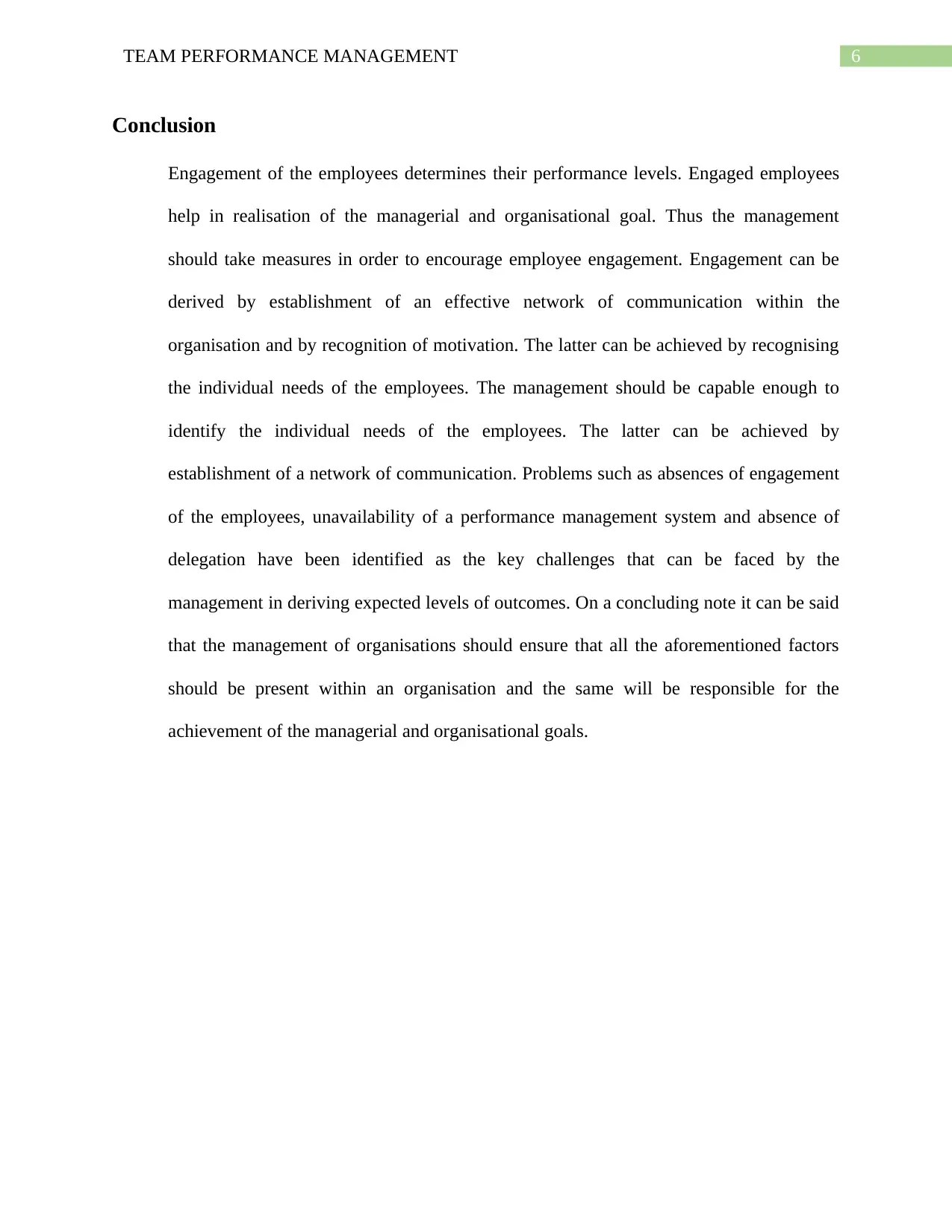
6TEAM PERFORMANCE MANAGEMENT
Conclusion
Engagement of the employees determines their performance levels. Engaged employees
help in realisation of the managerial and organisational goal. Thus the management
should take measures in order to encourage employee engagement. Engagement can be
derived by establishment of an effective network of communication within the
organisation and by recognition of motivation. The latter can be achieved by recognising
the individual needs of the employees. The management should be capable enough to
identify the individual needs of the employees. The latter can be achieved by
establishment of a network of communication. Problems such as absences of engagement
of the employees, unavailability of a performance management system and absence of
delegation have been identified as the key challenges that can be faced by the
management in deriving expected levels of outcomes. On a concluding note it can be said
that the management of organisations should ensure that all the aforementioned factors
should be present within an organisation and the same will be responsible for the
achievement of the managerial and organisational goals.
Conclusion
Engagement of the employees determines their performance levels. Engaged employees
help in realisation of the managerial and organisational goal. Thus the management
should take measures in order to encourage employee engagement. Engagement can be
derived by establishment of an effective network of communication within the
organisation and by recognition of motivation. The latter can be achieved by recognising
the individual needs of the employees. The management should be capable enough to
identify the individual needs of the employees. The latter can be achieved by
establishment of a network of communication. Problems such as absences of engagement
of the employees, unavailability of a performance management system and absence of
delegation have been identified as the key challenges that can be faced by the
management in deriving expected levels of outcomes. On a concluding note it can be said
that the management of organisations should ensure that all the aforementioned factors
should be present within an organisation and the same will be responsible for the
achievement of the managerial and organisational goals.
Paraphrase This Document
Need a fresh take? Get an instant paraphrase of this document with our AI Paraphraser
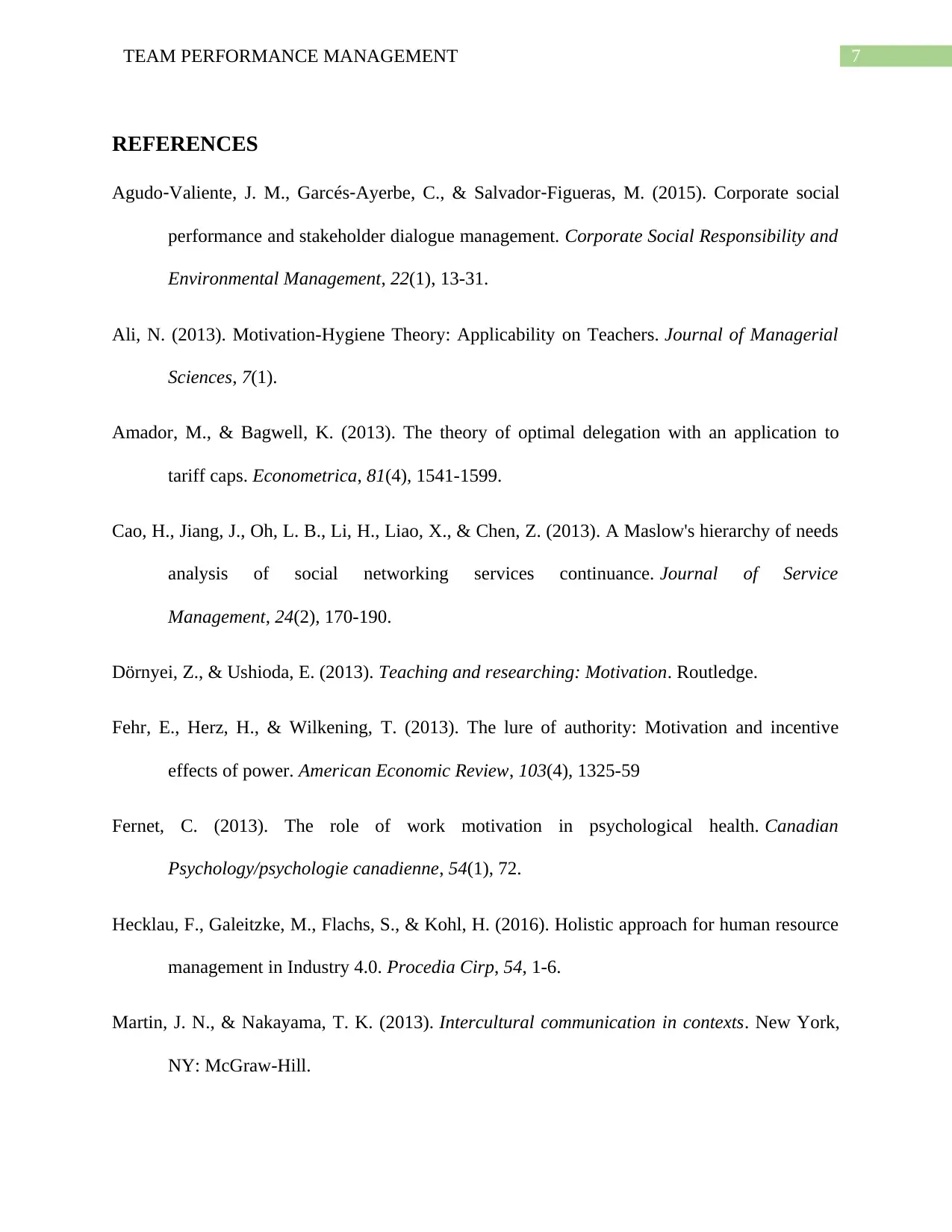
7TEAM PERFORMANCE MANAGEMENT
REFERENCES
Agudo‐Valiente, J. M., Garcés‐Ayerbe, C., & Salvador‐Figueras, M. (2015). Corporate social
performance and stakeholder dialogue management. Corporate Social Responsibility and
Environmental Management, 22(1), 13-31.
Ali, N. (2013). Motivation-Hygiene Theory: Applicability on Teachers. Journal of Managerial
Sciences, 7(1).
Amador, M., & Bagwell, K. (2013). The theory of optimal delegation with an application to
tariff caps. Econometrica, 81(4), 1541-1599.
Cao, H., Jiang, J., Oh, L. B., Li, H., Liao, X., & Chen, Z. (2013). A Maslow's hierarchy of needs
analysis of social networking services continuance. Journal of Service
Management, 24(2), 170-190.
Dörnyei, Z., & Ushioda, E. (2013). Teaching and researching: Motivation. Routledge.
Fehr, E., Herz, H., & Wilkening, T. (2013). The lure of authority: Motivation and incentive
effects of power. American Economic Review, 103(4), 1325-59
Fernet, C. (2013). The role of work motivation in psychological health. Canadian
Psychology/psychologie canadienne, 54(1), 72.
Hecklau, F., Galeitzke, M., Flachs, S., & Kohl, H. (2016). Holistic approach for human resource
management in Industry 4.0. Procedia Cirp, 54, 1-6.
Martin, J. N., & Nakayama, T. K. (2013). Intercultural communication in contexts. New York,
NY: McGraw-Hill.
REFERENCES
Agudo‐Valiente, J. M., Garcés‐Ayerbe, C., & Salvador‐Figueras, M. (2015). Corporate social
performance and stakeholder dialogue management. Corporate Social Responsibility and
Environmental Management, 22(1), 13-31.
Ali, N. (2013). Motivation-Hygiene Theory: Applicability on Teachers. Journal of Managerial
Sciences, 7(1).
Amador, M., & Bagwell, K. (2013). The theory of optimal delegation with an application to
tariff caps. Econometrica, 81(4), 1541-1599.
Cao, H., Jiang, J., Oh, L. B., Li, H., Liao, X., & Chen, Z. (2013). A Maslow's hierarchy of needs
analysis of social networking services continuance. Journal of Service
Management, 24(2), 170-190.
Dörnyei, Z., & Ushioda, E. (2013). Teaching and researching: Motivation. Routledge.
Fehr, E., Herz, H., & Wilkening, T. (2013). The lure of authority: Motivation and incentive
effects of power. American Economic Review, 103(4), 1325-59
Fernet, C. (2013). The role of work motivation in psychological health. Canadian
Psychology/psychologie canadienne, 54(1), 72.
Hecklau, F., Galeitzke, M., Flachs, S., & Kohl, H. (2016). Holistic approach for human resource
management in Industry 4.0. Procedia Cirp, 54, 1-6.
Martin, J. N., & Nakayama, T. K. (2013). Intercultural communication in contexts. New York,
NY: McGraw-Hill.
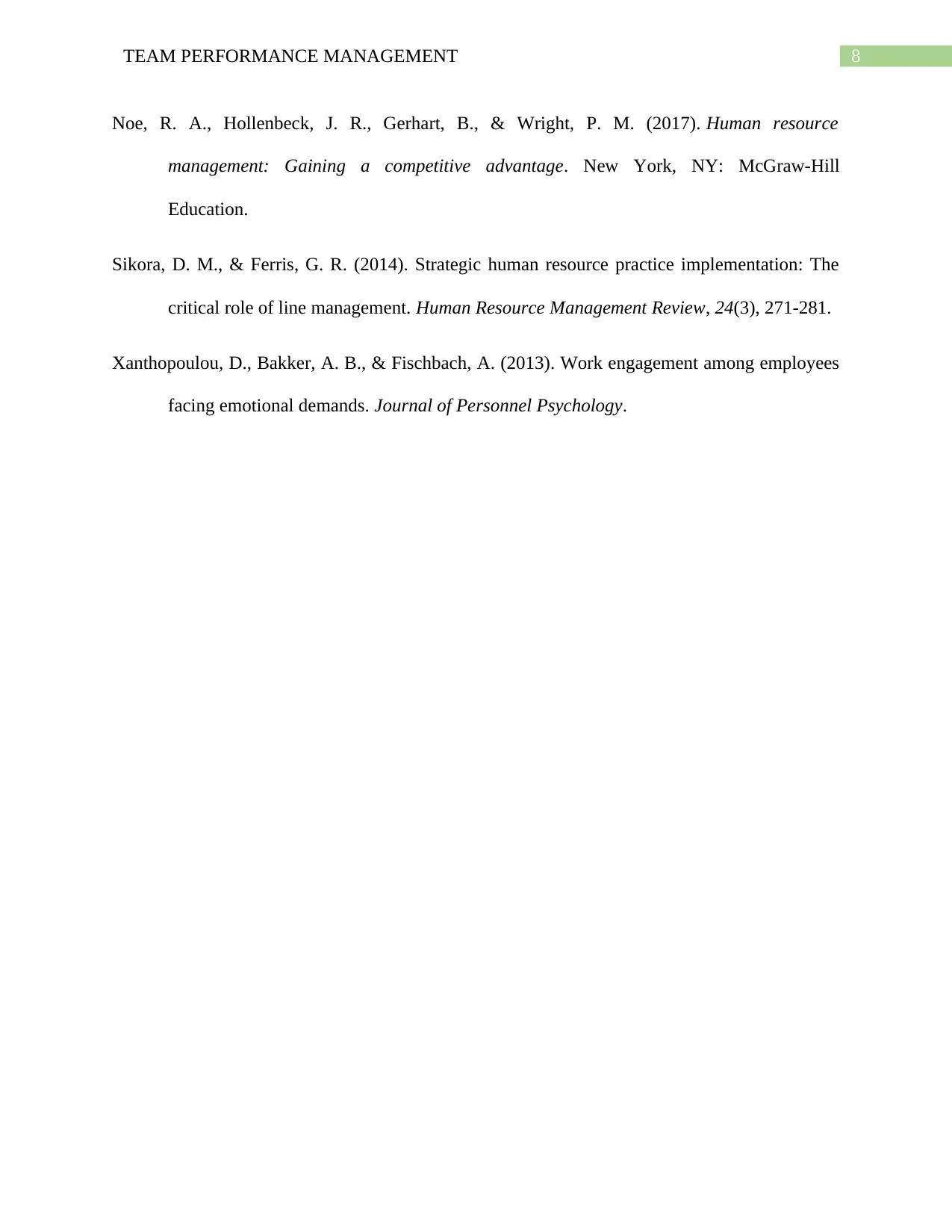
8TEAM PERFORMANCE MANAGEMENT
Noe, R. A., Hollenbeck, J. R., Gerhart, B., & Wright, P. M. (2017). Human resource
management: Gaining a competitive advantage. New York, NY: McGraw-Hill
Education.
Sikora, D. M., & Ferris, G. R. (2014). Strategic human resource practice implementation: The
critical role of line management. Human Resource Management Review, 24(3), 271-281.
Xanthopoulou, D., Bakker, A. B., & Fischbach, A. (2013). Work engagement among employees
facing emotional demands. Journal of Personnel Psychology.
Noe, R. A., Hollenbeck, J. R., Gerhart, B., & Wright, P. M. (2017). Human resource
management: Gaining a competitive advantage. New York, NY: McGraw-Hill
Education.
Sikora, D. M., & Ferris, G. R. (2014). Strategic human resource practice implementation: The
critical role of line management. Human Resource Management Review, 24(3), 271-281.
Xanthopoulou, D., Bakker, A. B., & Fischbach, A. (2013). Work engagement among employees
facing emotional demands. Journal of Personnel Psychology.
You're viewing a preview
Unlock full access by subscribing today!
1 out of 9
Related Documents
Your All-in-One AI-Powered Toolkit for Academic Success.
+13062052269
info@desklib.com
Available 24*7 on WhatsApp / Email
![[object Object]](/_next/static/media/star-bottom.7253800d.svg)
Unlock your academic potential
© 2024 | Zucol Services PVT LTD | All rights reserved.




